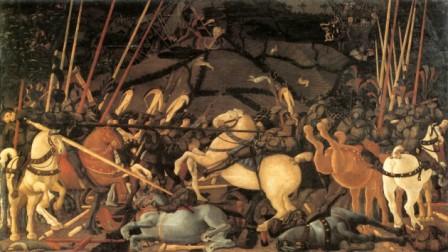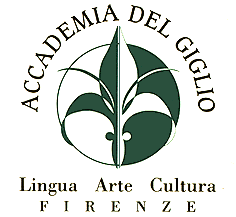 Paolo Uccello (1397-1475) is considered as one of the first masters of perspective in painting. Reportedly, Paolo was so impressed by the discovery of the perspective that he used to spend nights and days studying the correct foreshortening of the objects in his artworks. Looking at his famous painting named “Battle of San Romano” (Uffizi, Louvre, and National Gallery, London), it is possible to admire his experiments that led him to consider the figures as somewhat “carved” and not painted. That is why the picture looks like composed by wooden figures, and the whole painting seems very far from the dramatic and harsh reality of the war. In his “Lives of the Artists” Vasari reports a discussion between Paolo and Donatello, the great sculptor, during which the latter reproached his friend to dedicate to much of his energy in studying and investigating the problems of the perspective, which, in Donatello’s opinion, caused Paolo to abandon “the substance for the shadow ”. The sculptor was actually convinced that, if his friend had studied human bodies as accurately as he studied the perspective, he would soon become an excellent painter.
Paolo Uccello (1397-1475) is considered as one of the first masters of perspective in painting. Reportedly, Paolo was so impressed by the discovery of the perspective that he used to spend nights and days studying the correct foreshortening of the objects in his artworks. Looking at his famous painting named “Battle of San Romano” (Uffizi, Louvre, and National Gallery, London), it is possible to admire his experiments that led him to consider the figures as somewhat “carved” and not painted. That is why the picture looks like composed by wooden figures, and the whole painting seems very far from the dramatic and harsh reality of the war. In his “Lives of the Artists” Vasari reports a discussion between Paolo and Donatello, the great sculptor, during which the latter reproached his friend to dedicate to much of his energy in studying and investigating the problems of the perspective, which, in Donatello’s opinion, caused Paolo to abandon “the substance for the shadow ”. The sculptor was actually convinced that, if his friend had studied human bodies as accurately as he studied the perspective, he would soon become an excellent painter.
It was also said that Paolo used to be so busy in his studies that his friends as a joke would say he would hardly look up even when his wife called him to bed.
Besides, Paolo was also an expert in painting animals and he was so keen on them that his house was filled with paintings of cats, birds, dogs and also strange and fantastic creatures, also because he was so poor that he could not afford any pets. Since he always enjoyed painting birds he was named “Paolo Uccelli”, that is “Paolo of Birds”.
One of his most famous masterpieces is the series of frescoes for the cloister of Santa Maria Novella, where Paolo painted the Creation of the animals with such a variety of species belonging to water, earth, and air, the Creation of man and of woman and their Fall. In some of these frescoes he also represented the natural landscapes he could admire in the surroundings of Florence, so rich of well-labored fields. Similar landscapes were also painted by Paolo in the backgrounds of two well-known works representing Saint George and the Dragon (the second version is at the National Gallery of London). Finally, we cannot forget that for the same cloister Paolo painted also two stories about the Flood and Noah’s Ark.
Something about… Paolo UccelloScrivi un commento |







Commenti recenti